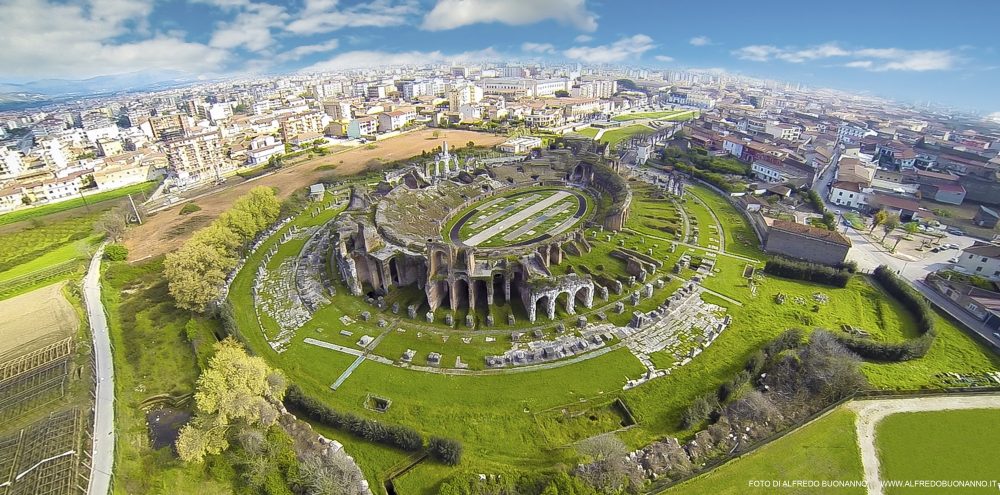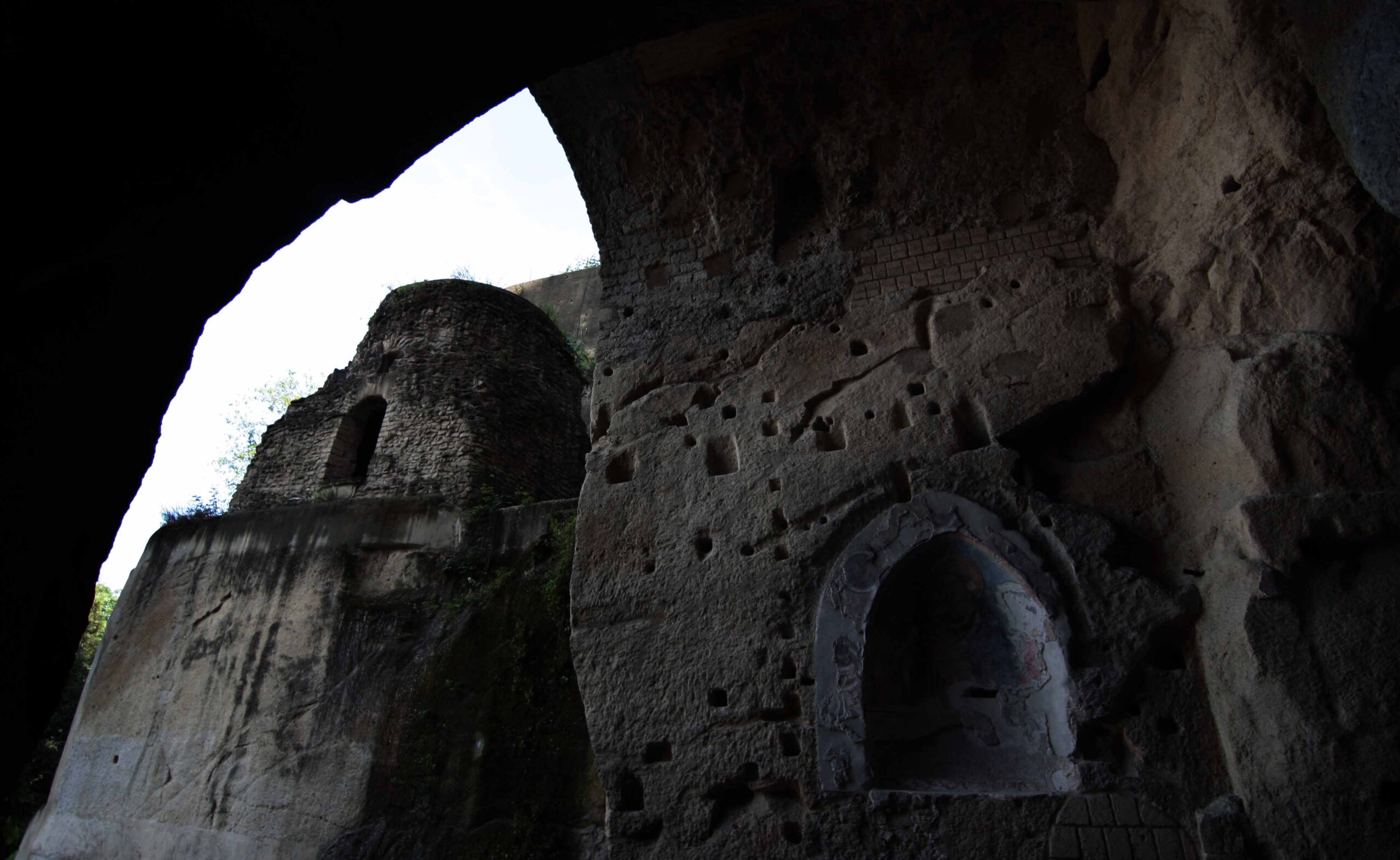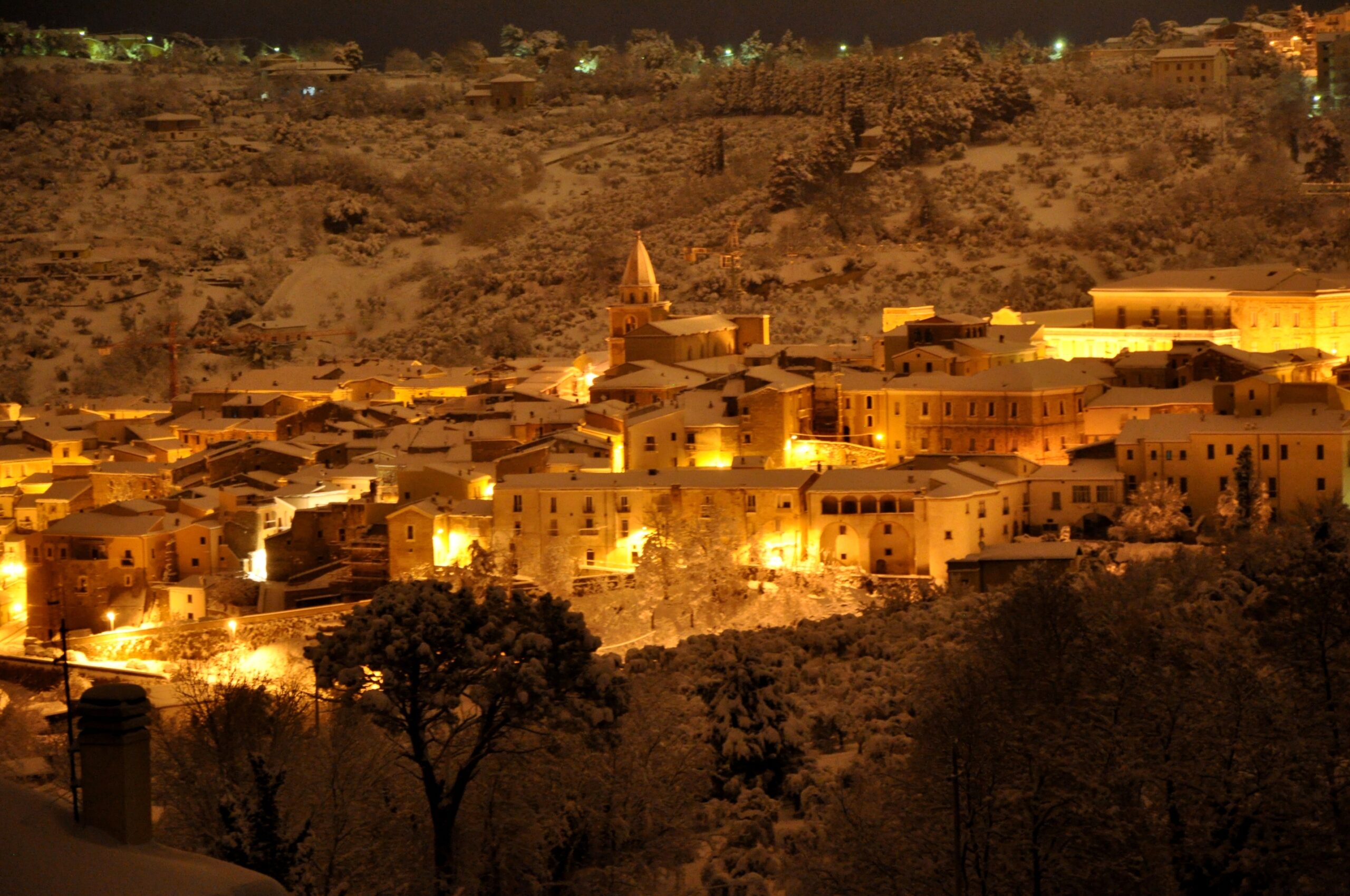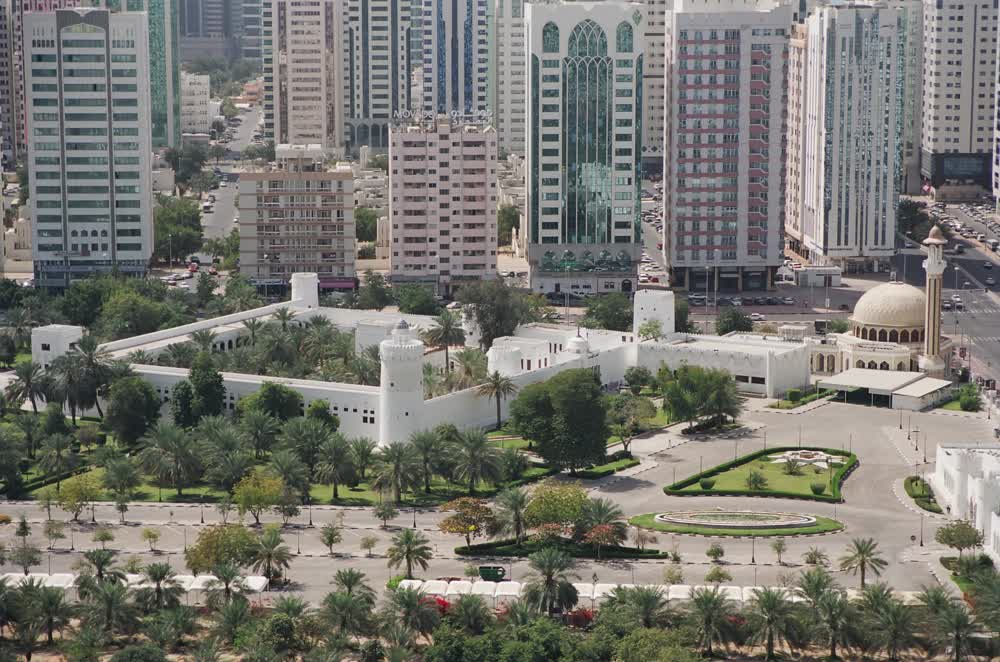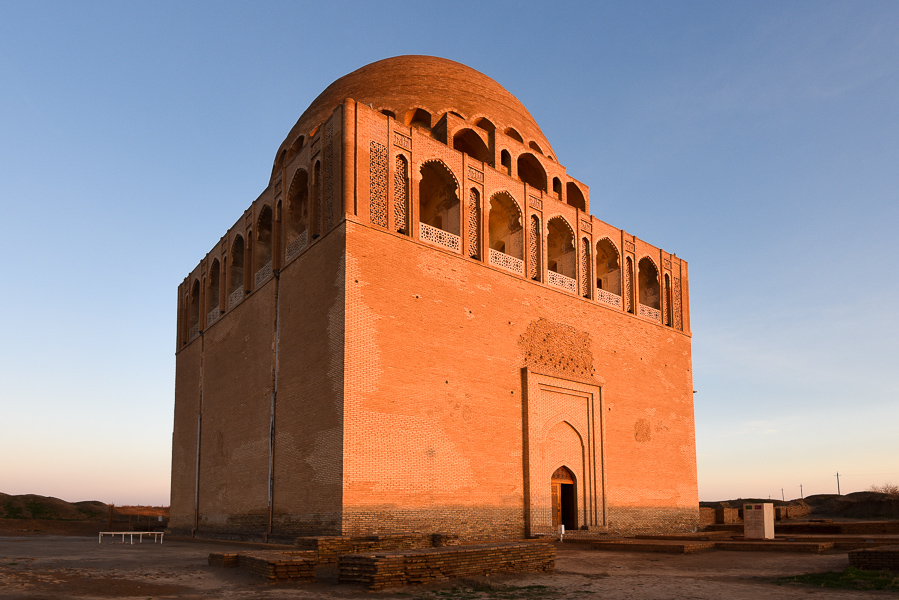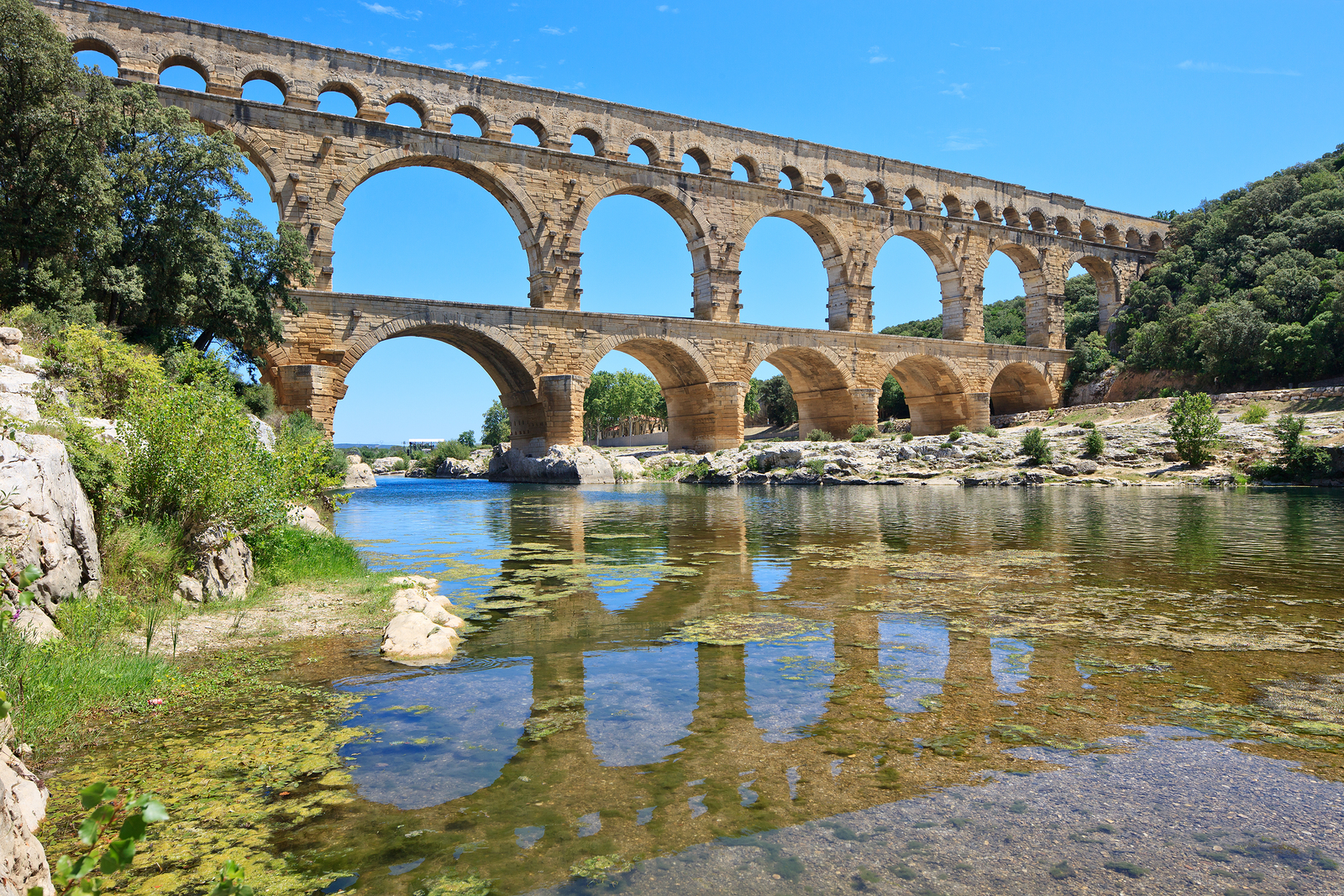The Campanian amphitheatre of Santa Maria Capua Vetere, the second largest among these types of monuments in ancient Italy after the Colosseum (165 m. on the major axis, 135 m. on the minor axis at arena level), was built between the end of the first and the beginning of the second century AD to replace the less capacious arena dating back to the Gracchan age, the remains of which have been found to the south-east.
An inscription dedicated by Antoninus Pius, partly preserved in the Museo Provinciale Campano, informs about its building history; it mentions the restoration of the colonnade and the new sculptural decoration made by the Emperor Hadrian.
The building, generally used for gladiatorial shows, originally had four canonical orders (ima, media and summa cavea, attic) of terraces, accessible by internal and external stairs, set on as many levels of galleries in opus latericium communicating, and opened in front with eighty arches made of limestone blocks of equal width except those placed at the four cardinal points, coinciding with the main entrances. They were emphasized by the presence of semi-columns resting on pillars in Tuscanic order, such as those partly preserved at the eastern entrance. The keys of the first two orders of arches of the facade were enriched by 240 busts in relief of deities, including: Jupiter, Juno, Demeter, Diana, Mercury, Minerva, Volturno, Apollo, and Mithras, as well as heads of Pan, satyrs and theatrical masks, in the third order; of these only 20 are preserved on site, a few others at the National Archaeological Museum of Naples and the Museo Provinciale Campano, while most were later reused as spoils.
The outer perimeter of the stalls surrounding the building, made of limestone blocks in concentric bands, was bordered by smooth and carved stones, of which there is only one with the relief image of Hercules on the facade towards the amphitheater and another with Silvanus on the outer facade, between the stones were installed barriers to separate the sidewalk from the surrounding area. The steps of the cavea were covered with marble and the summa cavea was surmounted by a portico decorated with statues and columns. The ornamental parts have almost all been lost, with the exception of a Venus, the so-called Adonis and the group of Cupid and Psyche; however, the frontonal plutei and the balustrades of the vomitoria (entrances to the terraces) have been preserved. The first ones, originally placed on the lintel of the door, show mythological and commemorative scenes in relief; the others, placed as handrails at the sides of the last steps, were carved on both sides with exotic animals or with hunting scenes among animals. The floor of the arena consisted of wooden planks sprinkled with sand to allow the conduct of fighting, under which developed the basement, communicating with each other through corridors and accessible by four stairs in the service areas, located behind the podium and used for machinery and scenic equipment. The main entrance that allowed to reach the basement and to bring the cages of the animals without passing through the arcades was located on the western side. On the eastern side there was also a conduit connecting to a cistern built in opus reticulatum, in which water was collected for the cleaning of the underground. In addition, a chapel built in the second nave to the north of the western entrance dates back to the V-VI century AD.
In 456 A.D. the amphitheatre was destroyed during the sack of Genseric, but it was repaired in 530 A.D.. During the Gothic and Lombard domination the building continued to function as an arena, then, after the destruction of the city in 841 AD by the Saracens, was transformed into a fortress. From the period of Swabian domination became a quarry for the extraction of stone materials reused in the construction of buildings of the city. Partially excavated between 1811 and 1860, it was finally freed from the huge piles of earth between 1920 and 1930, with numerous subsequent interventions of conservative restoration over time.
Annexed to the Amphitheatre is the ‘Museum of the Gladiators’ where, with innovative exhibition solutions, the surviving elements of the decoration of the Campanian Amphitheatre have been presented to the public for the first time. In the first room, on the right wall, there are three of the arch keys that decorated the outside of the monument: a male head with Phrygian cap identified as Mithras or Attis, a female head with diadem (perhaps Juno), a head of Minerva with Attic helmet and the cast of the bust of Volturno, whose original is kept at the Museo Campano. Below are some honorary inscriptions with dedications to the emperors Hadrian and Antoninus Pius, from the excavations of the amphitheater. In the middle of the room there is a plastic model reproducing the present state of the building and its original aspect. In the first showcase there is a selection of ceramic materials found in the area of the amphitheatre and sculptural fragments pertinent to its architectural decoration: ox-head corbels, a fragment of a lacunar and parts of the marble balustrades that adorned the cavea. The heads of Hercules, of Athena with Corinthian helmet, of Apollo and of a female divinity (perhaps Diana) belonged to the statues that adorned the arches of the upper floors.
In the second display case, casts of gladiatorial weapons found in Pompeii were exhibited as examples: two helmets, a pair of shields and a shoulder strap. The diorama placed between the showcases represents a combat between gladiators and beasts: one can recognize the reziario, with net and trident, the secutor with helmet and short sword, the thracian with griffin on his helmet and curved sword (sica) and the venator who faces a lion. In the second room, with an original setting that reproduces the steps of the cavea, the decoration of one of the vomitoria (entrances to the cavea) has been completely reconstructed; on the bottom there is a relief with a procession of magistrates and lictors, depicted in the act of entering the amphitheatre to take their seats. The side balustrades depict felines biting their prey; other fragments of side balustrades depict animals that seem to be running towards the arena: gazelles, bears, elephants and lions. Fragments of the frontal plutei are also placed on the walls of the same room. Among the themes represented are scenes of sacrifice, a depiction of the amphitheater under construction and mythological scenes; in particular, on the right wall, the exploits of Hercules (cleaning of the stables of Augia, Hercules and Antaeus) and two fragments with the Dioscuri. To the right of the entrance the punishment of Prometheus, the torture of Marsyas, Mars and Rhea Silvia, as well as a fragment with dancing Maenads and another with Apollo. To the left of the entrance there is also a scene with turreted gods, the construction of the amphitheater, the representation of a sacred enclosure, a scene of sacrifice for the dedication of the amphitheater. On the left wall there are scenes of centauromachia and Actaeon being eaten by dogs. The stylistic features of the reliefs, the choice of subjects and the way they are treated, responding to a strongly classical taste, indicate the Hadrianic age as the period of execution of the sculptures.
